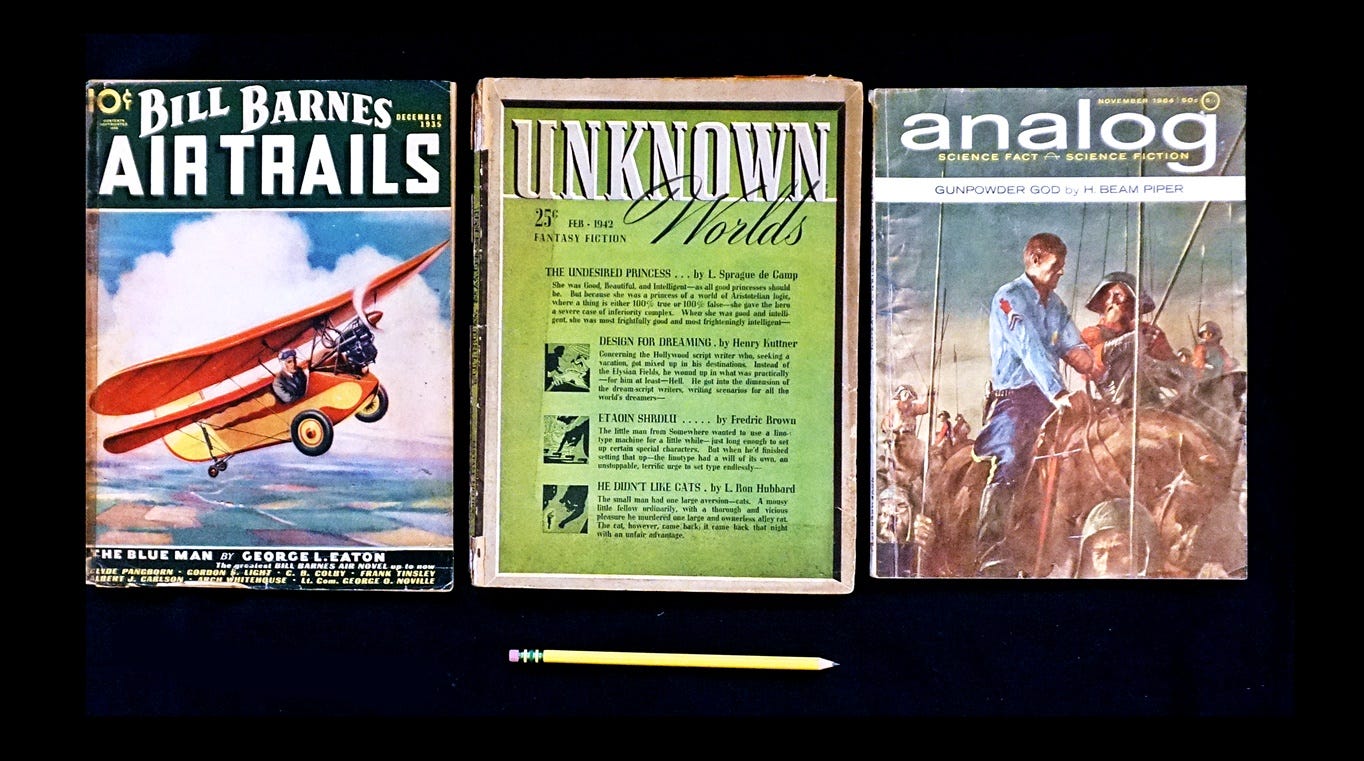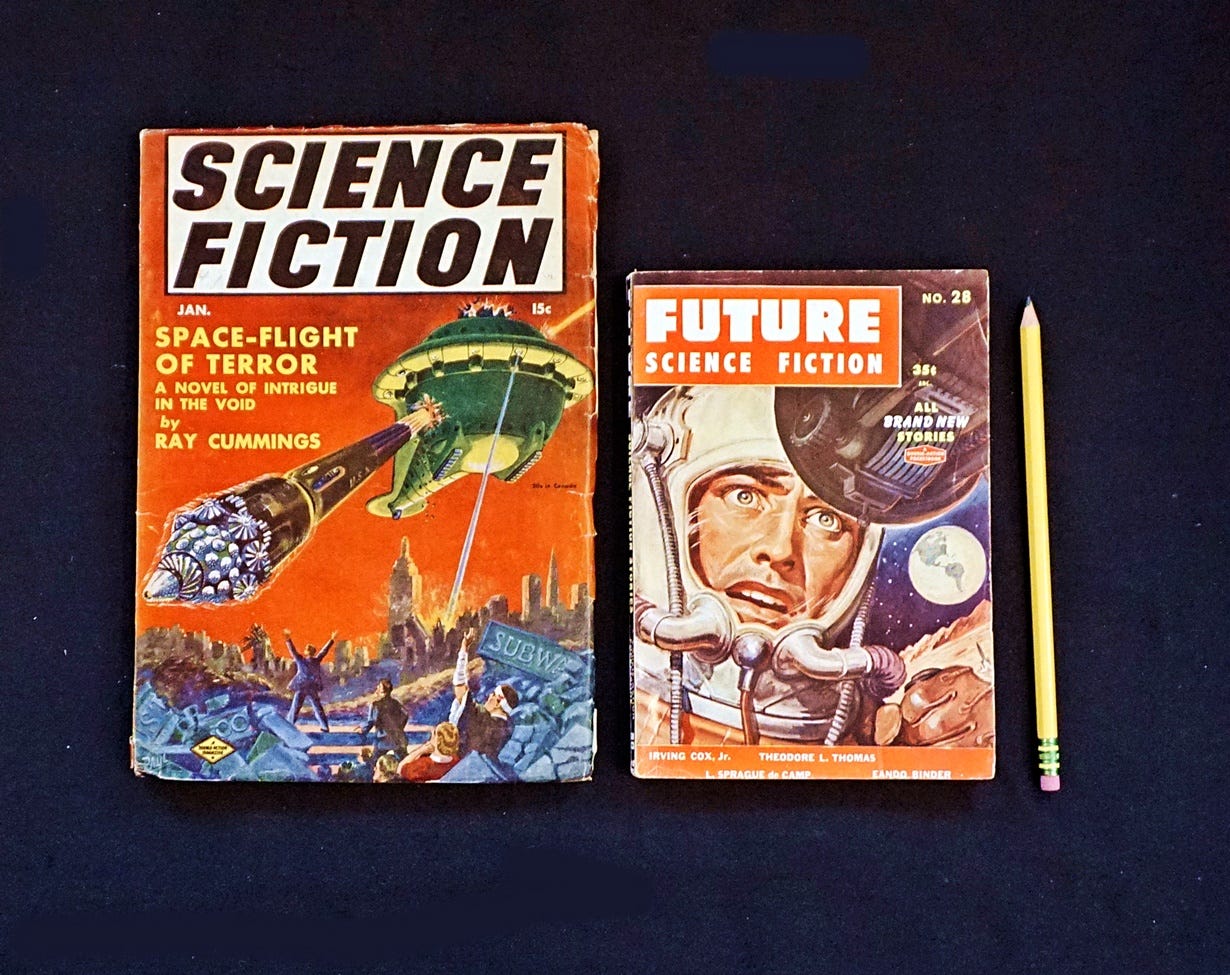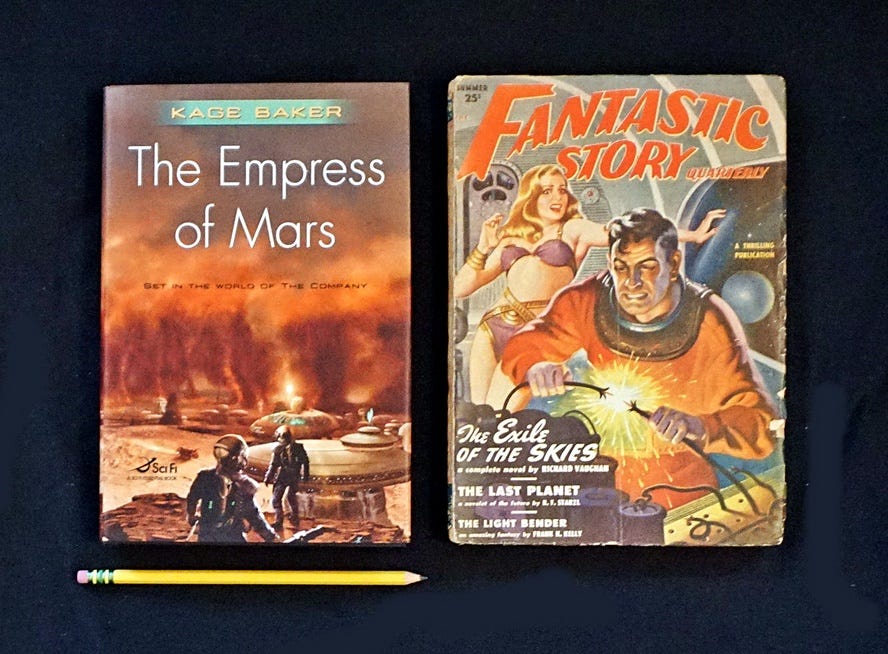
What’s a bedsheet, other than something you put on a bed? In terms of magazines it refers to a large periodical of approximately 8.5 x 11 inches, the size of LIFE magazine, for example. This is my favorite size of pulp magazine; there’s something very satisfying about holding such a large periodical in your hands. Most pulp magazines were smaller however, approximately 6 x 9 inches. This corresponds to the size of TIME magazine. Finally, digest-size pulps were about 5.5 by 8.25 inches and could easily fit into a large purse.
The pulps were printed on cheap paper and typically had rough, untrimmed edges. They contained three general categories of fiction—short stories, novelettes, and book length novels (which we would refer to as novellas.) Short stories were the most common and usually under 15,000 words. Novelettes, literally “little novels,” were anywhere from 15,000 to 40,000 words. Book lengths, generally 50,000 words or more, would run entire in some pulp magazines. Other magazines would serialize them in three or four consecutive issues.

Pulps were differentiated from the “slick” magazines in both paper and content. Magazines such the SATURDAY EVENING POST were printed on smooth, high-quality paper, hence being called a “slick.” Content differences between pulp and slick magazines were often worlds apart. Pulp stories were pure escapism and lured potential readers with colorful, bizarre, or sexy covers. The stories inside were equally high-octane. The slicks offered enjoyable but often “main stream” entertainment. Interestingly, from letters columns, we know that many pulps were passed around from family member to family member and friend to friend. I’m referring here to science fiction, adventure, sport, detective, mystery, and weird pulps and not the “spicy” or risqué pulps (although I’m sure they were passed around, too.) I suspect the Love Story and romance pulps were passed around amongst the ladies.

Pulp magazines reached their zenith during the 1930’s with over 1000 different titles published during that era. This is my favorite era of pulp stories. The genres are well established and heaven knows the readers needed escapism during the Great Depression. During World War II the printing industry ran into heavy paper shortages and that sounded the death knell for the pulps. Some of the magazines continued, notably ANALOG, which had started as ASTOUNDING during the 1930’s. By the 1950’s content had changed. GALAXY magazine and others were putting out more cerebral stories and speaking against the old escapist adventures of the pulp era.
Writers changed with the times, or couldn’t, and things moved on. While print publishers were moving science fiction into new directions, television was making its presence felt. During the 1950’s television became a game-changer. It was in TV programing that we see the continuation of pure escapist adventures. Often we see the names of pulp writers in the credits and this continued in popular shows throughout the 1960’s. Scripts for “Time Tunnel,” “Alfred Hitchcock,” “Twilight Zone” “Twenty Thousand Leagues under the Sea” and “Land of the Giants” are but a few of the television shows which employed well-known pulp writers.
Of course, we still have escapist adventure stories today. But there’s a difference. We are so steeped in political correctness that it seeps out of our pores. We are so afraid to speak about anything controversial that if we’re not willing to start a fight, we may choose not to speak. Mainstream publishing has been dying for several decades, the end of the road for a very programmed path. Independent publishing has created a vast pool of stories of varying quality. The road that led here from the pulp era was very deliberate on the part of publishers and media companies. And now we have a population that often chooses not to read, favoring other media instead. I must wonder if this wasn’t the plan all along—a populace who only interacts with socially-approved media. If this were the case then it seems to me that the old escapist adventures are a cure. They expand your world, if only for a moment. And that’s what we are desperately missing right now.
This is the Rocketeer signing off for today.







Oldest most relevant to you stuff is probably Stephen Fabian or Jack Vance related. Underwood-Miller limited editions or similar.
Otherwise a variety of science fiction and fantasy pulp, but more 60s and 70s. I don't have much in the way of pulp mags. A couple Galaxy's, but not many in serial format. Later collections in books of some things.
Used to collect more comic books, but now it's just a few cover artists I like, rather than for the reading as much.
I go through binges and purges occasionally, but the last one was about twenty years ago, so some things have piled up. So much still to read...
Actually, my OLDEST stuff is souvenir photography books and postcards from world's fairs. St Louis LPE 1904 and San Francisco PPIE 1915 mostly. A few odd others, but those are my faves. Architecture and art and sculpture mainly, but all the peculiarities as well...
And I'm interested in checking out some of the authors you've mentioned the next time we get to Grand Junction or the front range. Some good used bookstores in Denver and Boulder area that I miss.
You're conflating pulps and digests. All magazines are not pulps. Pulps are from a particular time and a particular grade of paper. ASTOUNDING was a pulp. ANALOG and GALAXY are digests. DEVIL ON THE MOON is just a paperpack.